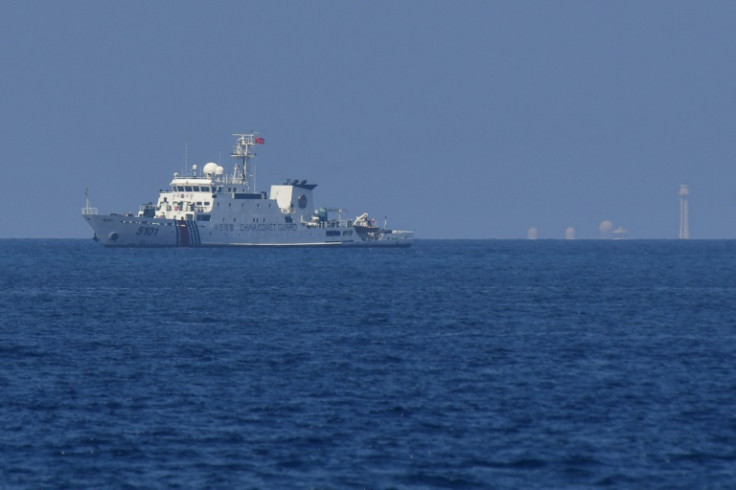Philippine Navy Warns Chinese PLAN Vessel After Shadowing Incident Near Civilian-Occupied Thitu Island

KEY POINTS
- The Chinese ship allegedly responded using its 'patently baseless 'ten-dash line' narrative'
- Thitu Island has been occupied by a Filipino community since 2001
- Tensions have been high in recent months in disputed areas such as Second Thomas Shoal and Scarborough Shoal
- Beijing called Thitu Island 'China's territory'
The Philippine Navy warned off a Chinese People's Liberation Army Navy (PLAN) vessel that was "blocking" its path and shadowed the former near Thitu Island in the disputed Spratly Islands.
The Philippine Navy "warned off and issued consecutive radio challenges" to the PLAN's 621 naval warship Friday "after it shadowed the former at an 80-yard (73 meters) distance and attempted to cross" the Philippines' BRP Benguet's (LS507) bow southwest of Thitu Island, which the Southeast Asian nation calls Pag-asa Island, on Friday, the Armed Forces of the Philippines (AFP) said in a Facebook post Sunday.
Philippine Navy vessel warns off China’s Navy vessel for dangerous maneuvers inside Pag-Asa Territorial Sea
— Armed Forces of the Philippines (@TeamAFP) October 15, 2023
Read more: https://t.co/gzT5WtkUHg#AFPyoucanTRUST pic.twitter.com/t8vWZEprX2
In a video posted on X, a Philippine Navy personnel could be seen sending a radio message to the Chinese ship in question, warning it of violating Rule No. 7 of the Convention on the International Regulations for Preventing Collisions at Sea (COLREGs 1972) "and endangering our safe navigation by blocking our course line." The personnel added that the Chinese warship was advised to "keep clear immediately and avoid risk of collision."
The AFP added that the BRP Benguet received a response from PLAN 621, with the Chinese ship's crew "using their so-called patently baseless 'ten-dash line' narrative."
While China has "shadowed" Philippine vessels multiple times in the past years in different areas across disputed territorial waters, incidents of Chinese ships showing up near Thitu Island have been increasing in recent months.
First taken by the Philippines in the 1970s, Pag-asa Island now has a 1,300-meter airstrip and other infrastructure that the Philippine government has been improving since it placed a civilian population on the island in 2001.
Responding to the shadowing incident, Chinese Foreign Ministry spokesperson Mao Ning on Monday said that Thitu Island, which it calls Zhongye Dao, was "China's territory" and it is "lawful and legitimate" for Chinese warships to implement patrols in the island's waters.
Zhongye Dao is China’s territory. It is lawful and legitimate for Chinese warships to sail and patrol in waters of Zhongye Dao. pic.twitter.com/GUcq4lvCkJ
— Spokesperson发言人办公室 (@MFA_China) October 16, 2023
The shadowing of the Philippine navy ship came on the same day the Philippines concluded its joint Exercise Sama-Sama (Together) 2023 with military personnel from the United States, Japan, the United Kingdom, France, Canada, and Australia. Indonesian and New Zealand navy troops also participated as observers.
Also, last week, the United Kingdom's Minister of State for Defense, Baroness Annabel Goldie, said Britain wants the Philippines to "feel supported" in the face of China's increasing threats in disputed waters across the South China Sea.
Goldie, who visited Manila late last week, added that the U.K. and the Philippines were "aligned in wanting to stand up for international law, wanting to have the United Nations Convention on the Law of the Sea (UNCLOS) both respected and implemented."
WELCOME ABOARD | UK Defense Minister’s visit to PH #Navy promotes deepening maritime ties 🇵🇭🤝🇬🇧
— Philippine Navy (@Philippine_Navy) October 13, 2023
More: https://t.co/cmmEydOod3#NavalDiplomacy #ProtectingtheSeasSecuringOurFuture #ModernandMultiCapablePHNavy #AFPyoucanTRUST pic.twitter.com/4DYheUxpLZ
Thitu Island, which is located north of the Spratly Islands, isn't the only disputed area between China and the Philippines. Other parts of the Spratly Islands such as the Second Thomas Shoal (Ayungin Shoal in the Philippines and Ren'ai Jiao in China) and the Scarborough Shoal (Bajo De Masinloc or Panatag Shoal in the Philippines and Huangyan Dao in China) have recently been at the center of increasing tensions between the Asian neighbors.
A maritime expert said last week that Beijing was "pushing" Manila to make the first move, so it could find an excuse to come up with an "overwhelming, disproportionate response." He said the Philippines shouldn't be provoked so as not to give China "any excuse" to strike first.
© Copyright IBTimes 2025. All rights reserved.





















